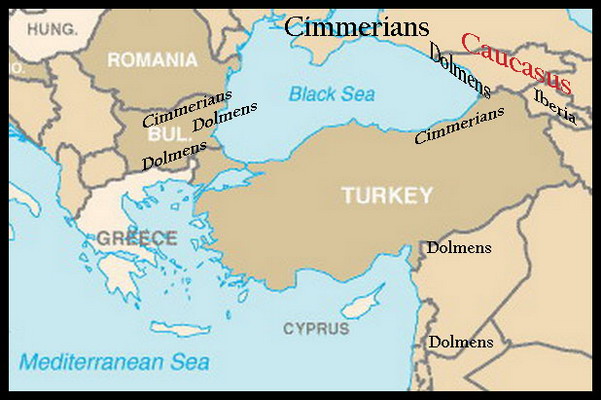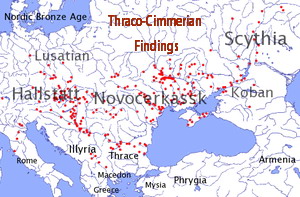Megaliths in the Caucasus and Bulgaria (11 September, 2014, 16 Elul, 5774)
Source: CIMMERIANS
http://www.iranicaonline.org/articles/cimmerians-nomads
Early Cimmerians in Southern Russia and the Caucasus
Cimmerians and Scythians are depicted differently according to which source is referred to.
Some archaeologists tend to identify the Cimmerians with the Chernogorovka and Novocherkassk cultures (ca. 900 to 650 BC) which were Iron Age steppe cultures in Ukraine and Russia, centered between the Prut and the lower Don. On the other hand they admit that the Cimmerians in other regions, such as the Caucasus are characterized by findings that are indistinguishable from the early Scythian ones.
The Greeks said the Cimmerians were different from the Scythians and fled from them.
Greek historians such as Herodotus distinguished between the earlier Cimmerians and the Scythians. Later Greek and Roman writers did the same. They traced the Cimmerians to the Celts and to the peoples of north and Scandinavia. The Scythians were considered to have come later. Assyrian records say the Scythians emerged from the Cimmerians. Rabbinical sources link the two: The Cimmerians were descendants of Gomer while the Scythians came from Ashkenaz the son of Gomer. They moved to Germany and the north.
The Greek historian, Herodotos, found traces of the Cimmerians in the Crimea.
Herodotus 4:
And to this day there are Cimmerian walls in Scythia, and a Cimmerian ferry, and there is a country Cimmeria [i.e. Crimea] and a strait named Cimmerian [Kerch Strait]. Furthermore, it is evident that the Cimmerians in their flight from the Scythians into Asia [i.e. Turkey] also made a colony on the peninsula where the Greek city of Sinope has since been founded; and it is clear that the Scythians pursued them and invaded Media, missing their way; for the Cimmerians always fled along the coast, and the Scythians pursued with the Caucasus on their right until they came into the Median land, turning inland on their way. That is the other story current among Greeks and foreigners alike.
On the Cimmerian Bosporos was the settlement Kimmerikon (late 500s BCE.-200s CE) which was settled by the Greeks who considered their predecessors in the place to a have been Cimmerian.
Archaeological findings to the south do not distinguish between Cimmerians and Scythians. The Cimmerians are sometimes identified with earlier Scythian findings.
If this sound confusing that is because it is confused.
Confused or not this is history and it is worth noting.
Academia tells us that:
In all Transcaucasian, Near Eastern (North Syria), or Anatolian (Turkey) regions connected with later Cimmerian activity only artifacts of early Scythian type have been found. Similar finds were also discovered at Tuva in southern Siberia, north of Mongolia.
In the late 700s BCE (or the 600s or later) bearers of this culture were moving westward. One group reached the land that is now Bulgaria; another had halted in northern Caucasia and at the same time partly penetrated into Transcaucasia and, in the 600s, as far as Anatolia. This last group is to be identified with the Cimmerians of the written sources.
It is in central Georgia that archeologists have found the greatest concentration of materials of the Scythian type, the earliest dating from about 700 BCE.
Transcaucasia was in fact the base from which Cimmerian troops are thought to have marched, probably until the beginning of the reign of Assurbanipal (668-ca. 625 BCE). In 679 the Cimmerian king Teushpa was defeated by the Assyrians near the city Ubushnu, perhaps in Cappadocia (northeast Turkey). In the same year Cimmerian detachments of individual soldiers (probably captives) were serving in the Assyrian army. In 675 they were present on the border of Mannea and in about 667 on Mannean territory. At different times Cimmerians were allied with Urartu and with the Medes. Cimmerians were serving as contingents in the Assyrian army in 671-70.
For the sake of convenience we shall accept the conventional usage and refer to early Scythian findings as Cimmerian.
Based on archaeological findings, indications in Greek writings, and possible hints in Assyrian texts we find Cimmerians (as well as Scythians) south of the Caucasus and north of it.
We have shown how the Exiled israelites from the Ten Tribes were to be identified as PART OF both the Cimmerian and Scythian hosts.
Megalithic monuments, such as dolmens, are to be found all over the Middle East.
We find dolmens in the Caucasus especially along the west coast.
Dolmens in the Caucasus have similarities to those in the Land of Israel and to those of Brittany [West France] and Ireland. Even so they are in a class of their own which is repeated in Bulgaria with the movement of Cimmerians to that country.
So too, in the Caucasus the dolmens are to be associated with a Cimmerian and early Scythian presence.
The dolmens in Bulgaria were associated with newcomers to the region. They spread over about 200 years after which they cease. Their builders had moved on to the west.

Archaeological findings associated with the Cimmerians were also to be found in what became the Celtic Civilizations of central Europe.
Thraco-Cimmerian
From Wikipedia, the free encyclopedia
http://en.wikipedia.org/wiki/Thraco-Cimmerian
This "migrationist" or "invasionist" view, assuming that the development of the mature Hallstatt culture (Hallstatt C) was triggered by a Cimmerian invasion, was the scholarly mainstream until the 1980s. In the 1980s and 1990s, more systematic studies of the artefacts revealed a more gradual development over the period covering the 9th to 7th centuries, so that today the "invasionist" scenario is considered untenable, and the term "Thraco-Cimmerian" is used by convention and does not necessarily imply a direct connection with either the Thracians or the Cimmerians.
Archaeologically, Thraco-Cimmerian artifacts consist of grave goods and hoards. The artifacts labelled Thraco-Cimmerian all belong to a category of upper class, luxury objects, like weapons, horse tacks and jewelry, and they are recovered only from a small percentage of graves of the period. They are metal (usually bronze) items, particularly parts of horse tacks, found in a late Urnfield context, but without local Urnfield predecessors for their type. They appear rather to spread from the Koban culture of the Caucasus and northern Georgia, which together with the Srubna culture, blends into the 9th to 7th centuries pre-Scythian Chernogorovka and Novocherkassk cultures. By the 7th century, Thraco-Cimmerian objects are spread further west over most of Eastern and Central Europe, locations of finds reaching to Denmark and eastern Prussia in the north and to Lake Zurich in the west. Together with these bronze artifacts, earliest Iron items appear, ushering in the European Iron Age, corresponding to the Proto-Celtic expansion from the Hallstatt culture.
Even though archaeologists, for the present, now tend to dismiss the concept of a Cimmerian (or "Thrako-Cimmerian") invasion of the west the finds exist. They were new to the area and are consistent with the coming of newcomers to the areas concerned.
An analysis of dolmens in the Middle East, the Caucasus, and Bulgaria will show that these were all erected by the one people and are consistent with the israelites having become identifed with the Cimmerians and moving westward. This will also provide additional proof that the megalithic monuments tracing a path between Israel and the West are to be dated to a time consistent with the migrations (after ca. 700 BCE in conventional chronology) of the Hebrew Nations.
Wikipedia dates the Caucasus dolmens to 3000 BCE and 2000 BCE.
See:
Dolmens of North Caucasus
http://en.wikipedia.org/wiki/Dolmens_of_North_Caucasus
From Wikipedia, the free encyclopedia
The Israelites were exiled from ca. 720 BCE. The Cimmerians left the Middle East and headed westward a little before 600 BCE. The Scythians did the same a little later.
How then could any of these peoples (Israelites, Cimmerians, or Scythians) have built the Caucasus dolmens?
We will see that Caucasus-type dolmens were built in Bulgaria in the period from ca. 700 (or later) to ca. 580 (or a little later) BCE.
They were built by a people who had come from outside the area and who afterwards moved on.
The dolmens in Bulgaria are considered both contemporary with those of the Caucasus and a continuation of them.
Obviously if the dolmens of Bulgaria belong to the era ca. 700-500 BCE they cannot be contemporary with those of the Caucasus where dolmens allegedly stopped being built in ca. 1500 BCE.
Someone has therefore got their chronology mixed up. It is not us.
The dating of the Caucasus dolmens is wrong.
They should be dated later than they are and their association with Israel and the Cimmerians acknowledged.
This issue will be discussed more in the coming articles.

